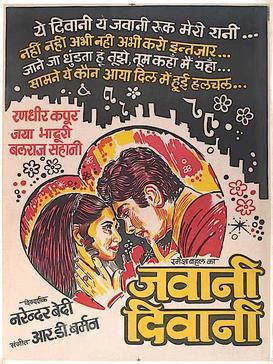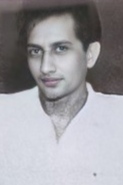
The Dadasaheb Phalke Award is India's highest award in the field of cinema. It is presented annually at the National Film Awards ceremony by the Directorate of Film Festivals, an organisation set up by the Ministry of Information and Broadcasting. The recipient is honoured for their "outstanding contribution to the growth and development of Indian cinema" and is selected by a committee consisting of eminent personalities from the Indian film industry. The award comprises a Swarna Kamal medallion, a shawl, and a cash prize of ₹1,000,000 (US$13,000).

Jaya Bachchan is an Indian actress and politician. She has served as a Member of Parliament in the Rajya Sabha from the Samajwadi Party. Known for her work in Hindi films, she is noted for reinforcing a natural style of acting in both mainstream and "middle-of-the-road" cinema. Bachchan has received several accolades, including nine Filmfare Awards and the Padma Shri, the fourth-highest civilian honour awarded by the Government of India.

Travancore Sisters refers to the trio of Lalitha, Padmini and Ragini who were actresses, dancers and performers in Malayalam, Tamil, Telugu, Hindi and Kannada films.
The Filmfare Best Cinematography Award is given by the Filmfare magazine as part of its annual Filmfare Awards for Hindi films.

Govind Nihalani is an Indian film director, cinematographer, screenwriter and producer, known for his works in Hindi cinema, particularly the movement of parallel cinema. He has been the recipient of six National Film Awards, and five Filmfare Awards.

Jawani Diwani is a 1972 Hindi-language musical romance film directed by Narender Bedi, and starring Randhir Kapoor, Jaya Bhaduri, Balraj Sahni, Nirupa Roy as leads. This was also Kader Khan's debut as a dialogue writer.

Rekha is an Indian actress who has had a prolific career in Hindi films, and is acknowledged as one of the finest actresses of Indian cinema. She first appeared as a child artist in two Telugu-language films Inti Guttu (1958) and Rangula Ratnam (1966), but her career as a lead started with the Kannada film Operation Jackpot Nalli C.I.D 999 in 1969. In that same year, she starred in her first Hindi film, Anjana Safar, which was delayed for ten years due to censorship problems. Her first Hindi release was Sawan Bhadon (1970), a commercial success which established her as a rising star. She followed with roles in Raampur Ka Lakshman (1972), Kahani Kismat Ki (1973), and Pran Jaye Par Vachan Na Jaye (1974), to mainstream success but little recognition for her acting, and press criticism of her looks and overweight. Rekha was motivated to improve her acting and appearance and managed a well-publicised transformation, both physically and in terms of her screen persona and command of the Hindi language. Her work in the 1976 drama Do Anjaane was better received, and critical recognition of her roles as a rape victim in Ghar and a courtesan in Muqaddar Ka Sikandar (1978) marked the beginning of the most successful period of her career.
Shodh is a 1979 Bollywood ghost movie directed by Biplab Roy Chowdhury and produced by Sitakant Misra, based on the Bengali book Gorom Bhat O Nichhok Bhooter Goppo by Sunil Gangopadhyay.
Tatineni Rama Rao was an Indian filmmaker. He directed 75 Hindi and Telugu feature films between 1966 and 2000.
Bazaar is an Indian Hindi language family-drama film of year 1949. The film is directed by K. Amarnath and produced under the banner Madhukar Pictures. The story was written by K. Amarnath, while the dialogue and lyrics were by Qamar Jalalabadi, with music by Shyam Sunder.
Gangavataran is a 1937 Indian film by Dadasaheb Phalke, who is known as the "father of Indian cinema". It was the first sound film and the last film to be directed by Phalke. When Phalke directed this film, he was 67 years old. He directed Gangavataran on behalf of Kolhapur Movietone.
Satyavadi Raja Harishchandra is a 1917 silent black and white Indian short film directed and produced by Dhundiraj Govind Phalke. The film is a shorter version of the first Indian feature film, Raja Harishchandra (1913), also directed and produced by Phalke. The intertitles used in the film were in Marathi language as the film was a silent film. The film is based on the mythological story of a Hindu King Harishchandra, the 36th king of the Solar Dynasty, who donated his entire kingdom and sold himself and his family to keep the promise given to the sage Vishvamitra in the dream.

Fali Mistry (1919–1979) was an Indian cinematographer, who worked in Bollywood films, from the 1940s to 1980, both in black and white and colour cinema, and along with younger brother Jal Mistry, he was one of the most acclaimed cinematographers of his era. He also produced and directed a few films.
Hindi film distribution circuits comprises territories which have been created by film distributors for releasing Hindi cinema or Hindustani cinema across India. The six distribution circuits were created in 1930s after the advent of the first talkie in 1931. These circuits were:
Amiya Chakravarty was an Indian film director, screenwriter and producer, who was leading film director in Hindi cinema of the 1940s and 1950s. He is noted for films like Daag (1952), Patita (1953), and Seema (1955) for which he won the 4th Filmfare Award for Best Story. Chakravarty is also credited along with Devika Rani for discovering Dilip Kumar, whom he gave his first break in 1944 film Jwar Bhata .Chakravarty also produced and directed Daag in 1952 for which Dilip Kumar won his first ever Filmfare Award for Best Actor.

Jal Mistry (1923–2000) was a noted Indian cinematographer who worked in Hindi cinema, best known for his collaboration with director Chetan Anand and Navketan Films, in films like Aakhri Khat (1966), Heer Raanjha (1970) and Kudrat (1981). Besides, hit films like Barsaat (1949) directed by Raj Kapoor and Naseeb (1981) by Manmohan Desai. He even co-produced Dev Anand starrer, Bombai Ka Babu (1960) with Raj Khosla.
Rajkamal Kalamandir was a noted film production company and studio in Mumbai. It was established by V. Shantaram in 1942, after he left Prabhat Films. The studio produced films both in Hindi and Marathi, and it was best known for Dr. Kotnis Ki Amar Kahani (1946), Amar Bhoopali (1951), Jhanak Jhanak Payal Baaje (1955), Do Aankhen Barah Haath (1957), Navrang (1959) and Pinjra (1972). In its heyday, Rajkamal was one of the most sophisticated studios of the country.

Saibal Chatterjee is an Indian film critic, editor and documentary screenwriter. He was a columnist at BBC News, Business Standard, Hindustan Times and The Financial Express. He has also written for The Telegraph, The Times of India, and Outlook. In addition, he has served as the editor of TV World; and a consultant to Zee Premiere. He presently reviews films for NDTV. He's a founder member of the Film Critics Circle of India (FCCI) and was a member of the editorial board of Encyclopædia Britannica's Encyclopaedia of Hindi Cinema. He has served on the team as well as jury of a variety of international film festivals. And was the festival director of the 2019 Pondicherry International Film Festival.

Smita Patil was an Indian film and theatre actress. Patil is regarded among the finest and greatest stage and film actresses in the history of Indian cinema. She appeared in over 80 films in several languages, but mostly in Hindi and Marathi, in a career that spanned just over a decade. Patil is a recipient of two National Film Awards, a Filmfare Award, two Filmfare Awards Marathi and received the Padma Shri, India's fourth-highest civilian honour in 1985.










